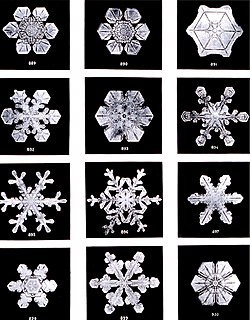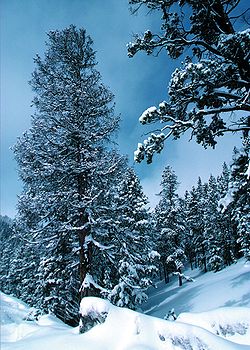Snow
From Wikipedia, the free encyclopedia.
- For other uses, see Snow (disambiguation).
Snow is precipitation in the form of crystalline water ice, consisting of a multitude of snowflakes. Since it is composed of small rough particles it is a granular material. It has an open and therefore soft structure, unless packed by external pressure.
Snow is commonly formed when water vapor undergoes deposition high in the atmosphere at a temperature of less than 0°C (32°F), and then falls to the ground. Snow can be also manufactured using snow cannons, which actually create tiny granules more like soft hail. (This is sometimes called "grits" by those in the southern U.S. for its likeness to the texture of the food.)
Contents |
Types
Very light snow falling is called flurries or just a flurry. Tiny icy granules of snow are called soft hail. Snow which has partially thawed and refreezed while falling is called sleet.
A snow squall is a brief, very intense snowstorm while a blizzard is a long-lasting snow storm with intense snowfall and usually high winds. Either storm can create whiteout conditions where visibility is reduced to zero while blizzards can also create large snowdrifts. A ground blizzard is a wind storm which drives already fallen snow to create drifts and whiteouts.
Occurrence
Snowfall varies by time and location, including geographic latitude, elevation and other factors which affect weather in general. In latitudes closer to the equator, there is less chance of snow fall, 35° is often quoted as a rough delimiter. The western coasts of the major continents remain snowless to much higher latitudes.
Some mountains, even at or near the equator, have permanent snow cover on their top, including Mount Kilimanjaro in Tanzania and the Tropical Andes in South America. Conversely, many regions of the Arctic and Antarctic receive very little precipitation and therefore little snow despite the bitter cold (below a certain temperature, air essentially loses its ability to carry water vapor).
Although density of fresh snow varies widely, a guide is that the depth of snowfall is 10 times that of a rainfall containing the same mass of water.
Substantial snowfall sometimes disrupts infrastructure and services even in regions that are accustomed to them. Traffic may be snarled or even completely stop. Basic infrastructure such as electricity, phones and gas supply can be shut down. A snow day is a day on which school or other services are cancelled owing to unusually heavy snowfall. In areas that normally have very little snow, this may occur even with light accumulation — something often made fun of by those people used to colder climates, where streets would remain passable given the same amount of snow.
The highest seasonally cumulative precipitation of snow ever measured in the world was on Mount Baker, Washington, U.S.A during 1998–1999 season when they received 28.96 meters (1,140 in); this surpassed the previous record holder, Mount Rainier, Washington, U.S.A which during 1971–1972 season received 1,122 inches (28.5 m) of snow; and the world record daily precipitation was recorded in Silver Lake, Colorado, U.S.A in 1921 1.93 metres (76 in).
See also: List of Countries receiving snowfall
Recreation
Forms of recreation dependent on snow:
- Many winter sports, such as skiing, snowmobiling, snowshoeing and snowboarding
- Playing with a sled or riding in a sleigh
- Building a snowman or snow fort
- Throwing snowballs mutually in a snowball fight or at others to tease them. (Humans seems to be the only animal that throw their snowballs. Pygmy chimpanzees have been seen carrying snowballs around, but never to throw them.)
Where snow is scarce but the temperature is low enough, snow cannons may be used to produce an adequate amount for such sports.
Tightly packed snow may be used as a construction material in, for example, Inuit snow houses.
The world´s biggest snowcastle is built in Kemi, Finland, every winter.
Geometry

An interesting question is why the arms of snowflakes are symmetrical, and why no two snowflakes appear to be identical. The answer is believed to be due to the fact that the distances between snowflakes are much greater than the distances across snowflakes.
The symmetry of snowflake arms is always six-fold, which arises from the hexagonal crystal structure of ordinary ice (known as ice Ih) along its 'basal' plane.
There are broadly, two possible explanations for the symmetry of snowflakes. Firstly, there could be communication (information transfer) between the arms, such that growth in each arm affects the growth in each other arm. Surface tension or phonons are among the ways that such communication could occur. The other explanation, which appears to be the prevalent view is that the arms of a snowflake grow independently in an environment that is believed to be rapidly varying in temperature, humidity and so on. This environment is believed to be relatively spatially homogenous on the scale of a single flake, leading to the arms growing to a high level of visual similarity by responding in identical ways to identical conditions, much in the same way that unrelated trees respond to environmental changes by growing near-identical sets of tree rings. The difference in the environment in scales larger than a snowflake leads to the observed lack of correlation between the shapes of different snowflakes.
However, the concept that no two snowflakes are alike is incorrect: it is entirely possible, but unlikely, that a pair of snowflakes may be visually identical if their environments were similar enough, either because they grew very near one another, or simply by chance. The American Meteorological Society has reported that matching snow crystals were discovered by Nancy Knight of the National Center for Atmospheric Research. The crystals were not flakes in the usual sense but rather hollow hexagonal prisms.
High-resolution gallery
See also

- Avalanche
- Sleigh
- Skiing
- Snow sculpture
- Snowball
- Snowboard
- Snowman
- Snow cannon
- Frost
- Snowshoe
- Snow removal
- Igloo
- Grit bin
- Lake effect snow
- List of countries receiving snowfall
- Sapir-Whorf hypothesis, the question of the number of Inuit words for snow








